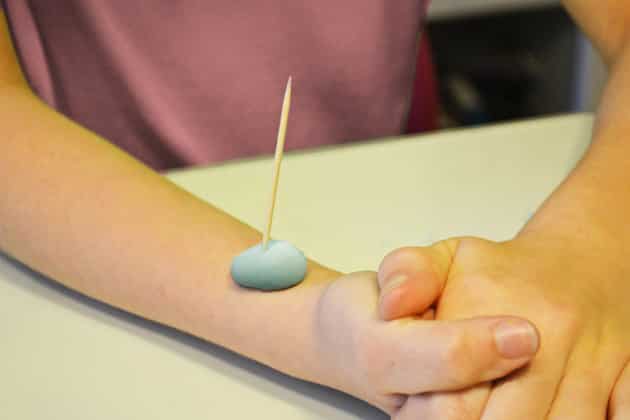Overview
Materials
Per Group:
|
Per Class (Optional):
|
Instructions
Students test their heart rate by monitoring their pulse after a range of activities and then think about how to track the health of their heart by using their heart rate.
PREPARATION:
Give students a basic understanding of the human heart and its role in the circulatory system so that students get the maximum benefit out of this activity.
ACTIVITY:
- Ask the students why a pulse might be an important thing to track. As needed, explain that listening to a pulse tells us a lot about the health of the heart. An irregular pulse could mean that some arteries—the major veins that carry blood throughout the body—are clogged, which could lead to a heart attack. When someone is injured, a pulse that is too fast or too slow reveals that something is very wrong and requires immediate action. Engineers have made many life saving devices that help medical professionals detect heartbeats and monitor the pulse of a patient.
- Explain to students that today they will monitor their own pulses.
- Divide students into groups of three and assign roles: one will be the recorder, one the timer, and one the pulse measurer. Distribute paper and a pencil to each member of the team.
- Ask students to write down their predictions to the question, “How many heartbeats do you think you will feel when you count your pulse for 1 minute?”
- Demonstrate where to find your pulse on your neck. Tell students to find their own pulse on their neck. Once they find it, instruct students to practice counting their pulse for about 10 seconds.
- Tell students that you are going to set your stopwatch for 1 minute. When you say “go”, they should count their pulse until you say “stop”, and then write that number down. Afterward, ask students to compare the number they counted to the number they predicted and report their results.
- Distribute clay, toothpicks, and stopwatches to each group.
- Provide the following instructions:
- Flatten the clay.
- Stick the toothpick in the clay.
- Ask one group member to sit down and turn their wrist so that their palm is facing up.
- Place the clay on this person’s wrist and rest it in different spots until you can see the toothpick vibrating, or moving back and forth a little bit.
- Tell the timer of the group to prepare to measure 1 minute. Tell the pulse measurer of the group to count how many vibrations the toothpick makes in 1 minute. The recorder writes this number down as the number of beats per minute, or BPM.
- Do the same for each member of the group, which will require swapping roles.
- Ask students if they think their heart beats at the same rate all the time, and why they think so. Then say that they are about to see if they are right.
- Instruct students to write down the following, in a column on their paper:
- Standing, 1 minute
- Jumping, 1 minute
- Tell students to stand still from when you say “start”, to when you say “stop”, 1 minute later. During this minute, they should count their pulse. Once you say stop, tell them to write down the beats per minute next to “Standing, 1 minute” on their paper.
- Then have students jump for one minute, then measure and record their pulse next to “Jumping, 1 minute.”
- Ask students to share their results. When was their pulse faster? By how many beats?
Guiding questions
-
Do you know of any other locations the pulse can be felt?
-
Do you think counting your pulse for 30 seconds and then doubling it would be as accurate as counting it for 1 whole minute? Why or why not?
-
Could you feel your heart pumping harder after you jumped in place for 1 minute? What did it feel like?
-
How do you think your pulse compares to a baby’s, or to your parents’, or to your grandparents’?
-
Do you think there’s a difference between the pulse of a long-distance runner and someone who sits and plays video games all day? Why or why not?
Engineering & science connections
- The heart works in a similar way to a water pump that brings water to the sinks all around your house. The pumping action makes rhythmic surges of blood as it travels from the heart through the body. This surge is called a pulse, which you can feel in places like the inside of your wrist. The average human heart beats more than 30 million times a year. That’s about 2.5 billion times in 70 years.
- Biomedical engineers developed the pacemaker, a small device that’s surgically placed in the chest or abdomen to help people with abnormal heart rhythms. Pacemakers use low-energy electrical pulses to prompt the heart to beat at a normal rate. Millions of people around the world are living longer, healthier lives with the help of pacemakers.
- Engineers also help doctors by developing stethoscopes to help doctors listen to people’s hearts and machines that monitor the heart rate of people who are sick or exercising. These include:
- Blood pressure cuff: measures blood pressure by applying pressure around the upper arm.
- Pulse oximeter: measures both heart rate and the amount of oxygen in the blood using a small probe that attaches to the finger.
- Heart monitor: monitors heart rate, rhythm, oxygen level, and blood pressure through small probes that stick to the patient’s chest. This is most often used when people are very sick or in the hospital.
The source of this activity is the TeachEngineering digital library collection at TeachEngineering.org. All rights reserved. Used with permission.


0 Comments